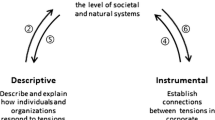Abstract
Theoretical models for estimating individuals' values for sure improvements in environmental quality are well developed. These models can be classified as being based on averting behavior, hedonic prices, or weak complementarity. Some of these models have also been applied to the task of valuing changes in risk based on expected utility theory. This article provides a systematic development of these models for changes in either the probability or the magnitude of an uncertain event and shows that the derived expressions for individual marginal willingness to pay can be generalized to nonexpected utility preferences as long as the index of preferences is continuous, convex, and twice differentiable.
Similar content being viewed by others
References
Berger, Mark C., Glenn C.Blomquist, DonKenkel, and George S.Tolley. (1987). “Valuing Changes in Health Risks: A Comparison of Alternative Measures,”Southern Economic Journal 53, 967–984.
Blomquist, Glenn. (1979). “Value of Life Savings: Implications of Consumption Activity,”Journal of Political Economy 87, 540–558.
Brookshire, David S., Mark A.Thayer, JohnTschirhart, and William D.Schulze. (1985). “A Test of the Expected Utility Model: Evidence from Earthquake Risks,”Journal of Political Economy 93, 369–389.
Cook, Philip J. and Daniel A.Graham. (1977). “The Demand for Insurance and Protection: A Case of Irreplaceable Commodities,”Quarterly Journal of Economics 91, 143–156.
Courant, Paul N. and RichardPorter. (1981). “Averting Expenditure and the Cost of Pollution,”Journal of Environmental Economics and Management 8, 321–329.
Cropper, Maureen L. and A. MyrickFreemanIII. (1989). “Valuing Environmental Health Effects,” In JohnBraden and CharlesKolstad (eds.),Measuring The Demand for Environmental Improvement. Springfield, IL: Illinois Department of Energy and Natural Resources.
Dardis, Rachel. (1980). “The Value of Life: New Evidence from the Marketplace,”American Economic Review 70, 1077–1082.
Fisher, Ann, Dan, Violette, and Lauraine, Chestnut. (1989). “The Value of Reducing Risks of Death: A Note on New Evidence,”Journal of Policy Analysis and Management 8, 88–100.
Freeman, A. MyrickIII. (1979).The Benefits of Environmental Improvement: Theory and Practice. Baltimore, MD: Johns Hopkins University Press for Resources for the Future.
Freeman, A. MyrickIII. (1985). “Methods for Assessing the Benefits of Environmental Programs.” In Allen V.Kneese and James L.Sweeney (eds.),Handbook of Natural Resource and Energy Economics, Vol. 1. Amsterdam: Elsevier Science Publishers.
Freeman, A. Myrick III. (1989). “Valuing Individuals' Changes in Risk: A General Treatment,” Resources for the Future Discussion Paper QE89-08, Washington, D.C.
Gerking, Shelby and Linda R.Stanley. (1986). “An Economic Analysis of Air Pollution and Health: The Case of St. Louis,”The Review of Economics and Statistics 68, 115–121.
Grether, David M. and Charles R.Plott. (1983). “The Economic Theory of Choice and the Preference Reversal Phenomenal,”American Economic Review 73, 560–595.
Harrington, Winston and Paul R.Portney. (1987). “Valuing the Benefits of Health and Safety Regulations,”Journal of Urban Economics 22, 101–112.
Jones-Lee, Michael W. (1974). “The Value of Changes in the Probability of Death or Injury,”Journal of Political Economy 99, 835–849.
Kahneman, Daniel and Amos, Tversky. (1979). “Prospect Theory: An Analysis of Decisions Under Risk,”Econometrica 47, 263–291.
Loomes, Graham and Robert, Sugden. (1982). “Regret Theory: An Alternative Theory of Rational Choice Under Uncertainty,”Economic Journal 92, 805–824.
MacDonald, Don N., James C.Murdoch, and Harry L.White. (1987). “Uncertain Hazards, Insurance, and Consumer Choice: Evidence from Housing Markets,”Land Economics 63, 361–371.
Machina, Mark J. (1983). “Generalized Expected Utility Analysis and the Nature of Observed Violations of the Independence Axiom,” In B. T.Stigum and F.Wenstop (eds.),New Foundations of Utility and Risk Theory with Applications. Dordrecht: Reidel Publishing Co.
Machina, Mark J. (1987). “Choice Under Uncertainty: Problems Solved and Unsolved,”Economic Perspectives 1, 121–154.
Mäler, Karl Göran. (1974).Environmental Economics: A Theoretical Inquiry. Baltimore, MD: Johns Hopkins University Press for Resources for the Future.
Rosen, Sherwin. (1974). “Hedonic Prices and Implicit Markets: Product Differentiation in Perfect Competition,”Journal of Political Economy 82, 34–55.
Shogren, Jason F. and Thomas D. Crocker. (Unpublished). “Risk, Self-Protection and Ex Ante Economic Value,” Department of Economics, University of Wyoming.
Shulstad, Richard N. and Herbert H.Stoevener. (1978). “The Effects of Mercury Contamination in Pheasants on the Value of Pheasant Hunting,”Land Economics 54, 39–49.
Smith, V. Kerry and William H.Desvousges. (1988). “Risk Perception, Learning, and Individual Behavior,”American Journal of Agricultural Economics 70, 1113–1117.
Smith, V. Kerry, William H.Desvousges, and A. MyrickFreemanIII. (1985).Valuing Changes in Hazardous Waste Risks: A Contingent Valuation Analysis, Draft Interim Report to U. S. Environmental Protection Agency. Nashville, Tennessee: Vanderbilt University.
Swartz, David G. and Ivar E.StrandJr. (1981). “Avoidance Costs Associated with Imperfect Information: The Case of Kepone,”Land Economics 57, 139–150.
Thaler, Richard. (1987). “The Psychology of Choice and the Assumptions of Economics,” In Alvin E.Roth (ed.),Laboratory Experimentation in Economics: Six Points of View. Cambridge: Cambridge University Press.
Thaler, Richard and Sherwin, Rosen. (1976). “The Value of Life Savings,” In Nester, Terleckyj (ed.),Household Production and Consumption. New York: Columbia University Press.
Viscusi, W. Kip. (1989). “Prospective Reference Theory: Toward an Explanation of Paradoxes,”Journal of Risk and Uncertainty 2, 235–264.
Author information
Authors and Affiliations
Additional information
I began this work while visiting at the Robert M. LaFollette Institute of Public Affairs, University of Wisconsin-Madison. I am grateful to Robert H. Haveman, the Director, for the opportunity to work there. I also want to acknowledge the very helpful discussions I have had with Maureen L. Cropper, Winston Harrington, Raymond Kopp, Paul Portney, and Kerry Smith without implicating them in any of the possible errors or deficiencies that remain in this article. A referee also provided useful comments.
Rights and permissions
About this article
Cite this article
Freeman, A.M. Indirect methods for valuing changes in environmental risks with nonexpected utility preferences. J Risk Uncertainty 4, 153–165 (1991). https://doi.org/10.1007/BF00056123
Issue Date:
DOI: https://doi.org/10.1007/BF00056123




